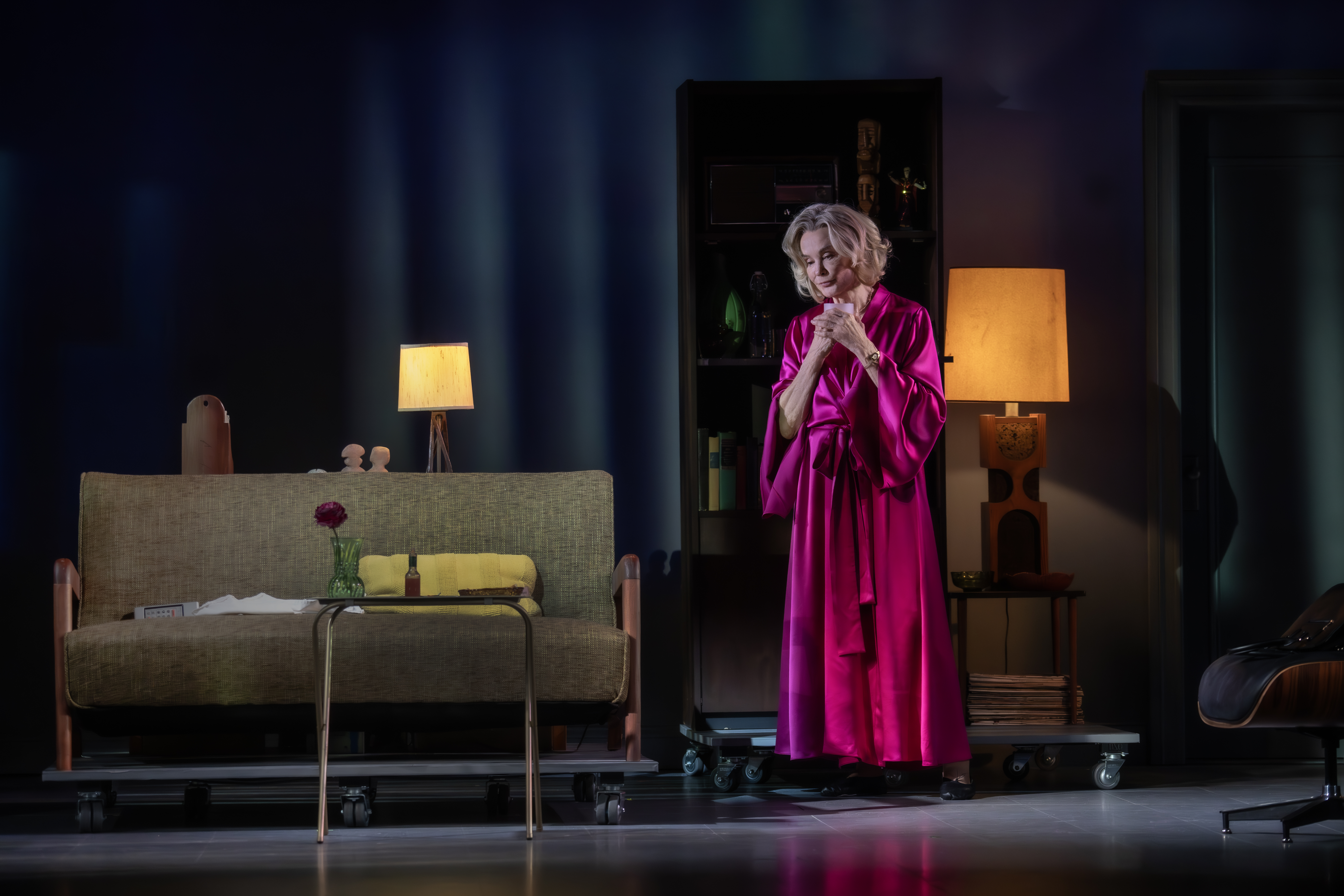In the Black

(Photo © Carol Rosegg)
People are always asking me, “What are you looking forward to seeing this season?” Recently, they’ve been expecting me to mention Spamalot or Dirty Rotten Scoundrels or the high-octane revivals of The Glass Menagerie and Who’s Afraid of Virginia Woolf? So they’re very surprised when I matter-of-factly state, “Falling Off Broadway.”
Most people don’t even know what that is. Like Whoopi, 700 Sundays, and Laugh Whore, this production (at the Sharp Theater, a couple of flights above Playwrights Horizons) is a one-person show. But its star is far less famous than Whoopi Goldberg or Billy Crystal; hell, he isn’t even remotely as well known as Mario Cantone! He’s David Black, who was a Broadway producer during the days (1961-1972) when a Broadway producer was an individual who could have his name — and his name alone — above a title. Granted, many of the productions that Black mounted did have someone’s moniker next to his, but some did not. He was a producer in the glorious, old-fashioned sense of the word in that he courted scripts, read them, and then got the ones that he liked best up on the boards.
Along the way, he worked with plenty of Tony Award-winning performers and directors, and provided audiences with a balanced diet from the four theatrical food groups: meaty new plays, fresh looks at the classics, commercial comedies, and big musicals. His first production was in 1961: Hugh Wheeler’s Look, We’ve Come Through, for which he shared a “produced in association with” credit with no less than Saint-Subber, who had produced Kiss Me, Kate and The Dark at the Top of the Stairs and would go on to bring us Barefoot in the Park and The Odd Couple. (By the way, no Pope canonized Saint-Subber. His first name was Arnold, and that’s how it appears in the credits of the Barefoot movie version, lest people unfamiliar with Broadway be terribly confused. Broadway certainly has had lots of angels but no real saints.)
With no high-profile writer or stars, Look, We’ve Come Through lasted five performances, but not because of bad reviews. Marilyn Stasio included it as one of the five well-received-but-no-hit plays that she championed in her book Broadway’s Beautiful Losers. And just as Wheeler wasn’t discouraged from proceeding — he’d later write the books for A Little Night Music and Sweeney Todd — Black would continue as well. His next project in 1962 had prestige galore: Henry James’ The Aspern Papers as adapted by Michael Redgrave, starring Maurice Evans and Wendy Hiller. It was a London import in the days when producers more often brought British plays than British musicals to Broadway.
In fact, it was Black’s next British import that made Broadway really take notice. Black had heard that Laurence Olivier was going to do a new play called Semi-Detached, so he tried to get the American rights before anyone else could. But, at the time, Broadway powerhouse David Merrick used to go shopping in London, too, and when he heard that Black was interested in producing Semi-Detached, he tried to wrest it from him. In those days, $500 would usually swing an option on a London script, but in this case the bidding war escalated until Black had to pay an unprecedented $25,000 for the rights. So David beat the Goliath whose name was also David. Alas, Olivier got rotten reviews for his performance in the London Semi-Detached and didn’t choose to come to America with the play. But Black still believed in the property and thought that Leonard Rossiter would make his career in the part. Everyone I know who saw the production at the Music Box in 1963 says that Rossiter was great — but no one knew who he was, and the show closed after two weeks.
What happened, though, was that because of the publicity about the expensive option, Black started getting scripts delivered to his door. These included one from his doorman’s relative — Ready When You Are, C.B.!, which Black read (how many producers would even bother to under those circumstances?) and produced with Julie Harris and Estelle Parsons. It wasn’t a hit, but the next one was, though it was a lousy show. Still, I applaud Black for going to City Center, seeing Alan King in Guys and Dolls, thinking he was good, and playing his hunch that the comedian from TV could sustain a star vehicle. The Impossible Years ran two full seasons and brought a lot of pleasure to a lot of people, even if I wasn’t one of them.

David Merrick again came into play with two of Black’s next three productions. Sure, the great impresario was interested in a musical about George M. Cohan — especially since it was co-written by Michael Stewart, who’d given him two hits with Carnival and Hello, Dolly!. But Stewart said to his boss, “I have written a play, Mr. Merrick!” It was called He to Hecuba, and — how about this for a fascinating idea? — it told of a troupe of strolling players in the 11th century who drop by a Danish castle called Elsinore and are requested by a kid named Hamlet to present that big hit, The Murder of Gonzago. Stewart demanded that if Merrick wanted to present George M! he’d also have to produce He to Hecuba. Merrick said no but Black said yes, and he got Alfred Drake and Jane Greenwood to appear in the retitled Those That Play the Clowns. Did it run? Hell, Hamlet‘s never amassed more than 137 performances on Broadway in any single production, so how well could a play that illuminates one section of it be expected to do?
When Black was readying George M! in 1968, Merrick was worried that the show might prevent his big musical of that season, The Happy Time, from winning the Best Musical Tony. He worked hard to have the cutoff date for awards consideration changed from April 15 to April 1, so that George M! — set to opening on April 10 — wouldn’t be eligible. Merrick had a lot of clout and he made it happen, but so many Tony voters were soured by the move that they didn’t vote for The Happy Time, and the pathetic, already closed Hallelujah, Baby! emerged victorious.
Broadway was changing and regional theater was getting into the act. No longer were playhouses in the hinterlands content with serving warmed-over productions of The Mousetrap or The Torchbearers. Still, going to a college to see a new play was where a lot of producers drew the line — but not Black. He went to Brandeis University in Waltham, Massachusetts in May 1968 to see Fire, an allegory by an unknown playwright named John Roc. Actually, Roc was a pseudonym for a well-known
playwright: N. Richard Nash, author of both The Rainmaker and its musical version, 110 in the Shade. (An aside: My girlfriend and I saw Fire at Brandeis and loved it so much that we named our son after the lead character.) Allegories don’t go on Broadway, and Fire burned out after a weekend, but give Black credit for having the courage to bring something quite radical to town.
Black was also partly responsible for Stephen Sondheim finally getting good reviews for his score for A Funny Thing Happened on the Way to the Forum: He co-produced the 1972 revival with Phil Silvers (who won a Tony) and Larry Blyden (ditto). The critics finally got on the ball and said that Sondheim had provided darned good songs for the show. (They had felt otherwise when it opened in 1962.) But the production didn’t run, probably because the show had only been away from Broadway for eight years. And that was basically it for Black, who saw himself — to cite the title of his new show — falling off Broadway. I’m looking forward to hearing many a juicy backstage story in his and-then-I-produced show.
********************
[To contact Peter Filichia directly, e-mail him at pfilichia@theatermania.com]











